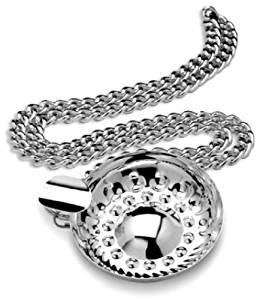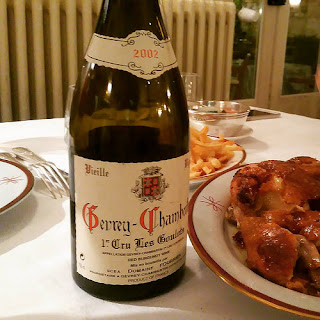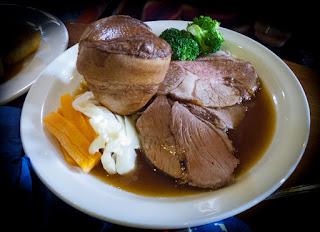from
Behind the French Menu
by
Bryan G. Newman
behindthefrenchmenu@gmail.com
A tastevin for sale on Amazon.
The tastevin
The tastevin is a cup made in silver and traditionally worn on a silver chain by many a restaurant’s sommelier, its wine steward. A tastevin may look like a silver ashtray, but its design was created to reflect light when looking at wine in dark caves lit only by candles. The concave indentations in the traditional tastevin allow the cellar master to see if the wine was clear and to note the contrast and the depth of the wine’s color; all by the light of a candle. Only then would the cellar master sniff and taste the wine. Today the tastevin is worn by the professional sommeliers who know a great deal about wines, and especially the wines of Burgundy.
The sommelier
Wines are a very very important part of France’s gastronomic universe. Hardly any Frenchman or woman would consider sitting down to dinner without a wine or other alcoholic beverage accompanying the meal. The choice of wines on a restaurant’s wine list is the job of the sommelier.
Viewing the clarity and color of the wine.
www.flickr.com/photos/isante/4817028323/
The sommelier has not just risen within the restaurant’s rankings though he or she will undoubtedly have worked as a server at some time. Along the way, the sommelier will have spent from three to five years studying the wines of France and the world. Then, after a few years, as another’s sommelier’s deputy, he or she will be given the responsibility for approving and managing a restaurant’s wine stock.
The sommelier’s years of study included visiting the vineyards, the vintners, and the cellars. Then they must invest time and money in acquiring the nose and taste buds that can identify the wines along with the knowledge of how to age them. The public will have expert advice along with information on a wine’s history and its suitability for pairing with a particulate dish. The restaurant's owner will have a manager who knows how to taste and compare wines, and when to buy. The sommelier controls stock levels and ensures the storage of the wine in a manner that allows them to age gracefully.
A sommelier decanting a wine.
Older wines, from ten or more years ago, along with wine produced by traditional methods, may have sediment. The bottle will have been stood upright for at least 24 hours before serving so the sediment will settle. Then, by decanting, often through a filter, the sediment will be removed.
www.flickr.com/photos/vinofamily/3467201365/
Managing the wines.
In many restaurants, the cost of the wines that are stored is the owner’s most significant investment. The wines and liquors in the cellar may cost more than the furnishings of the restaurant and its kitchen. Aging wines is not just a matter of having a cellar with a suitable temperature it is also the manner of storage. Cellars have different temperatures at different levels, and the humidity changes slightly throughout the year. The bottles must be properly laid down and regularly turned. Wines often do not grow old gracefully on their own. Bottles that may cost hundreds of US dollars may still need to have their corks changed over the years, and that is not an inexpensive matter nor a straightforward decision.
228-liter barrels aging in a Burgundy cellar
www.flickr.com/photos/25850415@N02/2443502546/
The Confrérie des Chevaliers du Tastevin,
France has hundreds of Confréries. These are brother and sisterhoods dedicated to enjoying and promoting the wines, cheeses, fruits, and other food products in French cuisine. The Confrérie des Chevaliers du Tastevin, the brother, and sisterhood of the Knights of the Tastevin are based in Burgundy and promote the wines of Burgundy. This Confrérie owns the Château of the Clos de Vougeot in Burgundy, which has been its headquarters since 1935. The Confrérie offers its members and guests excellent food and plenty of wine at their monthly meetings.
A ceremony with the Confrérie des Chevaliers du Tastevin.
www.flickr.com/photos/tourismesurlacotedenuits/15308052238/
Here, in the Clos de Vougeot the wines of Burgundy are tasted and honored. The Confrérie also awards prizes for art honoring Burgundy and has annual charitable events. Despite its charities, its grand celebrations aim to promote the great wines of the Bourgogne, Burgundy. That, and keeping the sommeliers of France informed and happy is its real raison d’être. The Chevaliers du Tastevin is not a small confrerie. Its membership honors thousands of outstanding people from celebrated artists to Noble prize winners. They, in turn, acknowledge the charms of the wines of Burgundy and France.
Château de Clos de Vougeot
www.flickr.com/photos/navin75/15008110607/
The Confrérie des Chevaliers du Taste-Vin has an English language website:
View a YouTube video of the introduction of new members of the Knights of the Tastevin:
Watching a master sommelier.
In a beautiful French restaurant in Basel, Switzerland, six of us sat down to dine with a French colleague who was a gourmand and a knowledgeable oenophile, a lover of fine wines. Our colleague ordered a bottle of Gevrey Chambertin, one of Burgundy’s excellent reds. The bottle chosen was an eight-year-old wine that came from a vintner he knew well. After our hors-d'oeuvre and entrée, (the French first course), our host ordered a second bottle. When wine from a single vintner is aged correctly two bottles of the same vintage should taste the same. Here, the sommelier did precisely what he was supposed to do. He tasted the few teaspoonfuls of wine left in the first bottle using his tastevin. Then he tasted the wine from the second bottle. The wine passed the sommelier’s test and he poured the wine into the existing glasses. There was no need to change the glasses or to offer the wine to be tasted again.
A 2002 Gevery-Chambertin
www.flickr.com/photos/eprater/26005156540/
The sommelier was brilliant, no overacting. Nonetheless, his whole manner showed the importance and solemnity of the occasion. The wines were his responsibility, and his face showed quiet concentration. With the taste of the wine from the new bottle came a light smile of appreciation and approval. What a superb professional. The wine was the exactly the same, as expected, but this sommelier's low keyed and self-assured performance made a great meal and a great wine genuinely memorable.
Connected Posts:
Behind the French Menu’s links include hundreds of words, names, and phrases that are seen on French menus. There are over 470 posts that include over 4.000 French dishes with English translations and explanations. Just add the word, words or phrase that you are searching for to the words "Behind the French Menu" and search with Google or Bing.













